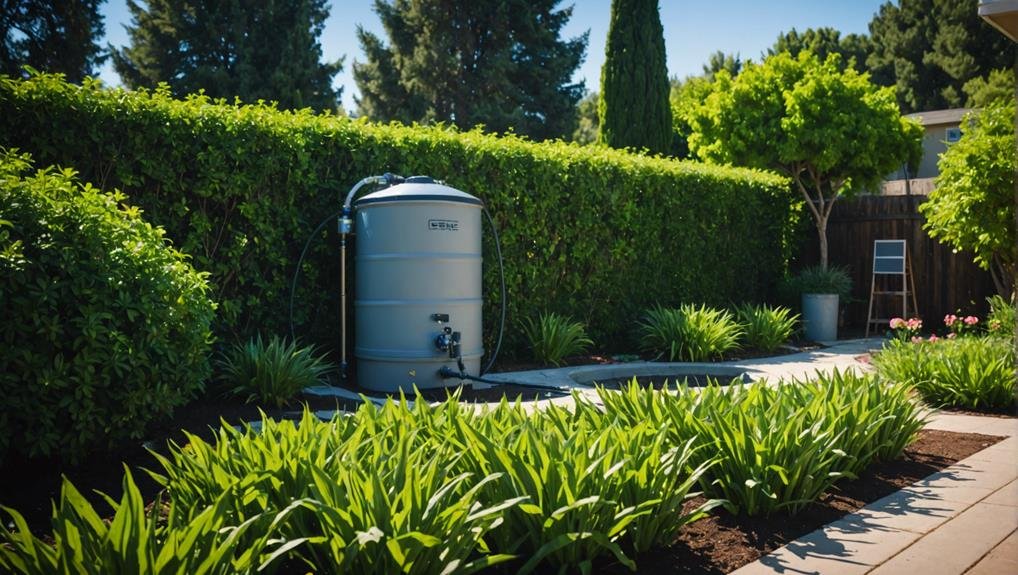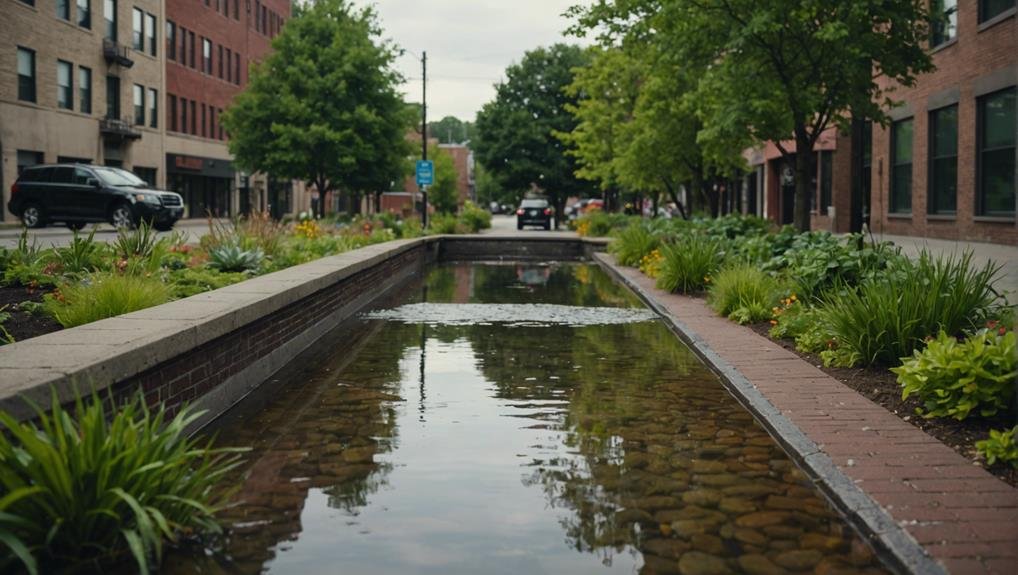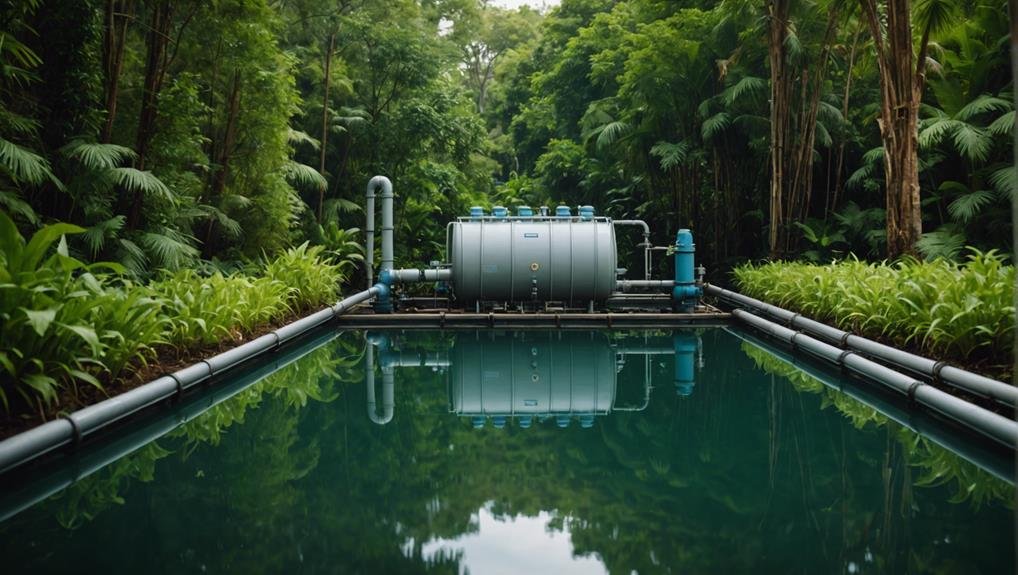We tackle common water quality issues with effective techniques. Filtration and sedimentation work to remove particles, while disinfection methods such as UV light and chemical treatments eliminate harmful microorganisms.
By reducing plastic waste and opting for reusable items, we can help prevent contamination. Water conservation practices like taking shorter showers and using efficient toilets can significantly reduce overall water consumption.
Regular maintenance of septic systems is crucial to prevent leaks, while green infrastructure and detention basins help manage stormwater effectively. Implementing sustainable agricultural practices and denitrification techniques can control runoff and nitrate pollution.
It is essential to conduct thorough water quality monitoring to ensure safe drinking water and maintain healthy ecosystems. Delving deeper into these solutions can provide valuable insights on how to address water quality challenges effectively.
Wastewater Treatment Technologies
Wastewater treatment technologies utilize various methods such as filtration, sedimentation, and disinfection to remove contaminants from sewage, contributing to the mitigation of water pollution. Filtration involves the removal of large particles and debris, while sedimentation allows heavier particles to settle at the bottom for easier removal.
Disinfection techniques, such as chemical treatment or UV light exposure, effectively eliminate harmful microorganisms, ensuring the treated water is safe for release back into the environment.
Advanced techniques like activated sludge and chemical treatment play a crucial role in further improving water quality. Activated sludge employs microorganisms to break down organic matter in wastewater, thereby reducing pollution levels through the conversion of contaminants into less harmful substances.
Chemical treatment methods like coagulation, flocculation, and ozonation are also vital in enhancing water purification processes. Coagulation and flocculation induce contaminants to clump together, facilitating their filtration, while ozonation employs ozone gas to degrade pollutants effectively.
These advanced technologies collectively contribute to the efficient treatment of wastewater, safeguarding water resources and ecosystems.
Reducing Plastic Waste
Minimizing plastic waste is crucial in safeguarding water quality and marine life as we combat water pollution on various fronts. Every year, a staggering 9-12 million tons of plastic find their way into the ocean, wreaking havoc on aquatic ecosystems.
To combat this issue effectively, it's imperative to focus on reducing plastic waste through conscious decisions in our daily routines.
One impactful way to reduce plastic waste is by opting for reusable water bottles instead of single-use plastic ones. By making this simple switch, we can significantly decrease the amount of plastic waste generated.
Similarly, replacing disposable plastic utensils with durable, reusable options like metal or bamboo can further contribute to waste reduction. Additionally, choosing eco-friendly alternatives such as paper or metal straws instead of plastic ones can make a positive difference in minimizing plastic pollution.
In addition to these individual actions, recycling plastic whenever possible plays a crucial role in mitigating the amount of waste that ends up in our water bodies. Properly disposing of plastic items through recycling initiatives helps in reducing environmental contamination and protecting our precious water resources.
Implementing Water Conservation

Water conservation is crucial for protecting our environment and preserving essential water resources. Simple habits like turning off taps when not in use and taking shorter showers can make a significant impact.
Installing water-efficient toilets, which use as little as 0.8-1.1 gallons per flush, is a practical way to save water and money. In our gardens, using water sparingly and only when necessary can help reduce water consumption and maintain water quality.
By adopting these water-saving practices, we can also help prevent water pollution. For example, by avoiding overwatering our lawns, we can minimize runoff that may carry harmful pollutants into nearby water sources.
Conserving water not only benefits the environment but also ensures clean water availability for the future. Every small effort counts towards safeguarding our precious water resources.
Let's continue to be mindful of our water usage and make a positive impact on our environment.
Managing Septic Systems
Properly managing our septic systems is crucial to prevent groundwater contamination and maintain water quality. Septic tanks are vital in separating solid waste from liquids, with natural processes breaking down the solids to ensure that the liquid effluent released is properly treated, reducing water pollution and protecting the environment.
To ensure the efficient operation of septic tanks and safeguard water quality, it's essential to follow these key practices:
Regular Inspections and Pumping: Scheduled inspections and pumping of septic tanks are essential to prevent overflow and leaks that can lead to groundwater contamination.
Mind What You Dispose of: Avoid flushing non-biodegradable items and harmful chemicals, as they can disrupt the sewage treatment process and harm the system.
Conserve Water: By reducing water usage, you can lessen the strain on the septic system, helping it operate efficiently and preventing potential overflows.
Maintain the Drain Field: Keeping the area around the drain field clear of heavy objects and excess water is crucial to allow proper absorption of the liquid effluent. This helps maintain the overall health and functionality of the system.
By following these practices, you can ensure the proper functioning of your septic system, protect water quality, and contribute to environmental conservation efforts.
Effective Stormwater Management

To effectively manage stormwater and reduce urban runoff pollution, it's crucial to implement various pollution control strategies. Urban runoff pollution occurs when rainwater flows over surfaces like streets, picking up pollutants along the way.
One of the most efficient methods to combat this is by utilizing green infrastructure, such as rain gardens and permeable pavements, which naturally absorb and filter stormwater. These green solutions not only decrease runoff volume but also enhance water quality.
Additionally, installing detention basins can be beneficial as they temporarily hold stormwater, allowing sediments and pollutants to settle before releasing the water. Swales, which are shallow channels designed to manage water flow, and vegetated buffer strips, planted areas between water bodies and potential pollutants, are also effective in treating stormwater.
These features help slow down water movement, encourage infiltration, and filter out harmful contaminants.
Sustainable Agricultural Practices
Sustainable agricultural practices play a crucial role in reducing water pollution by minimizing the use of chemicals and promoting soil health. These methods are essential for protecting our environment and improving water quality.
One important technique is crop rotation and cover cropping. Crop rotation involves changing the types of crops grown in a specific area each season, which helps break pest and disease cycles and reduces the need for synthetic fertilizers.
Cover cropping involves planting certain crops to cover the soil, preventing erosion and enriching the soil with organic matter.
Conservation tillage is another key practice that helps reduce soil erosion and sediment runoff into water bodies. By tilling the soil less frequently and less deeply, this method maintains soil structure and moisture, preserving water quality.
Precision irrigation systems are also crucial for sustainable agriculture. These systems deliver water directly to plant roots, minimizing water wastage, runoff, and evaporation, thereby conserving water resources and maintaining water quality.
Integrated pest management (IPM) is a sustainable approach to pest control that reduces the reliance on chemical pesticides. By using natural predators and other methods to manage pests, IPM helps prevent water pollution from pesticide runoff, promoting a healthier environment for all.
Denitrification Techniques

Denitrification techniques play a crucial role in converting harmful nitrates in water into harmless nitrogen gas, safeguarding aquatic ecosystems from contamination. The focus is on reducing excess nitrates in groundwater to prevent water quality issues.
Agricultural runoff often leads to elevated nitrate levels, promoting algae growth in water bodies. This rapid algae growth not only disrupts aquatic ecosystems but also degrades water quality, posing risks to both human and aquatic life.
One effective denitrification method involves utilizing microbial processes to transform nitrates into nitrogen gas, which is then released into the atmosphere. This process is vital for maintaining balanced nitrogen levels in ecosystems, preventing nitrate pollution and its harmful impacts on aquatic life.
Constructed wetlands are another valuable technique for filtering nitrates from water naturally. Implementing these methods ensures the health of our water systems, protecting them from the detrimental effects of nitrate pollution.
Monitoring Water Quality
To ensure denitrification techniques are effective, it's essential to monitor water quality by measuring key parameters such as pH, dissolved oxygen, turbidity, and conductivity. Monitoring these parameters is vital for understanding the current status of water quality and identifying any changes or potential sources of pollution.
Monitoring water quality is crucial for various reasons. Firstly, it's important for securing safe drinking water by ensuring it's free from harmful contaminants. Secondly, it helps safeguard aquatic ecosystems by monitoring dissolved oxygen levels and turbidity to maintain a healthy environment for aquatic life.
Additionally, water quality monitoring aids in detecting pollution sources promptly, allowing for quick intervention to prevent significant harm. Moreover, advanced technologies like remote monitoring systems enhance efficiency by providing accurate data without constant manual intervention.
Various tools are utilized for effective water quality monitoring. pH sensors are used to measure water acidity or alkalinity, while sensors for dissolved oxygen and conductivity offer insights into water health and cleanliness. Turbidity sensors measure water cloudiness, indicating the presence of suspended particles.
Real-time monitoring enables prompt responses to any changes, ensuring water safety and thriving ecosystems.
Conclusion
When it comes to addressing common water quality issues, we've explored a range of methods, from improving wastewater treatment to implementing sustainable agricultural practices.
A particularly notable fact is that effective stormwater management has the potential to reduce pollutants in urban runoff by as much as 80%.
By putting these strategies into action, we aren't only safeguarding water quality but also promoting a healthier environment overall.
By staying vigilant with monitoring and embracing innovative solutions, we can effectively confront these challenges and protect our water resources for the benefit of future generations.

